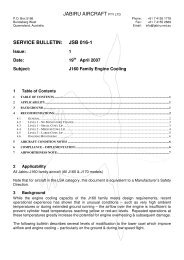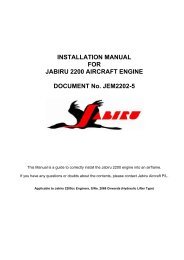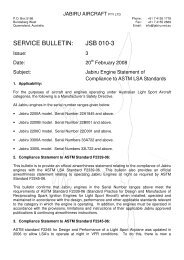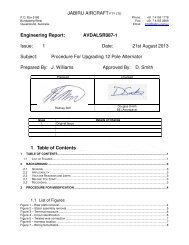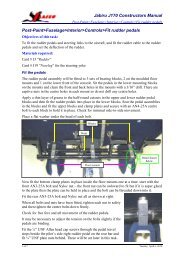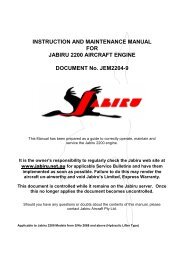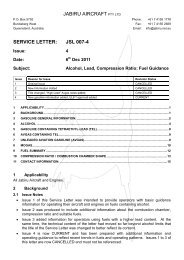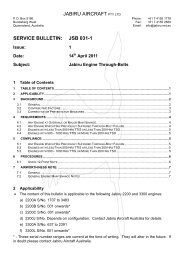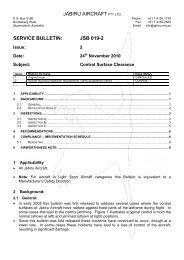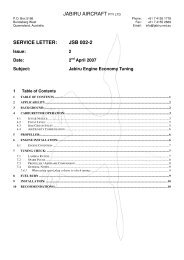Propeller Technical Manual - Jabiru
Propeller Technical Manual - Jabiru
Propeller Technical Manual - Jabiru
You also want an ePaper? Increase the reach of your titles
YUMPU automatically turns print PDFs into web optimized ePapers that Google loves.
<strong>Propeller</strong> <strong>Technical</strong> <strong>Manual</strong><br />
JPM0001-1<br />
<strong>Jabiru</strong> Aircraft Pty Ltd<br />
4A482U0D And 4A484E0D <strong>Propeller</strong>s<br />
3.2 <strong>Propeller</strong> Tuning – <strong>Jabiru</strong> Airframes<br />
<strong>Propeller</strong> pitch information is given in Table 3 and Table 4 for <strong>Jabiru</strong> Aircraft models.<br />
The propeller must be installed as detailed in Section 4.7.3.<br />
Note the inspection requirements of Section 4.6: inspections are required after installation & initial running.<br />
3.3 <strong>Propeller</strong> Tuning – Non-<strong>Jabiru</strong> Airframes<br />
The following information has been included to assist operators in setting up their 4A482U0D propeller for<br />
their non-<strong>Jabiru</strong> airframe.<br />
The propeller must be installed as detailed in Section 4.7.3.<br />
Note the inspection requirements of Section 4.6: initial inspections are required after installation and initial<br />
running.<br />
WARNING<br />
CORRECT PROPELLER ADJUSTMENT IS VITAL FOR THE LIFE OF THE ENGINE<br />
OPERATION WITH INCORRECT PROPELLER ADJUSTMENT MAY RESULT IN ENGINE DAMAGE.<br />
Operators must ensure that the propeller is adjusted to a pitch setting which matches the power output of<br />
the engine. This can be achieved by balancing the following considerations:<br />
- The propeller should be adjusted so that the engine will achieve 3200 – 3300 RPM in full power<br />
straight and level flight at sea level.<br />
- <strong>Propeller</strong>s fitted to 2200 engines should achieve 2800 – 3000 RPM at the aircraft’s best climb speed.<br />
- <strong>Propeller</strong>s fitted to 3300 engines should achieve 2800 – 3000 RPM at the aircraft’s best climb speed.<br />
- The 2200 engine should use 14 – 17 Litres of fuel per hour at cruise power.<br />
- The 3300 engine should use 23 – 26 Litres of fuel per hour at cruise power.<br />
- Cruise should be carried out at around 22 inhg manifold pressure (at Sea Level).<br />
- EGT and CHT must remain within the limits given in the Engine Maintenance <strong>Manual</strong> (of the Pilot’s<br />
Operating Handbook or Flight <strong>Manual</strong> for the aircraft.).<br />
Extensive testing has shown that these parameters will provide the best balance of performance.<br />
When compared with wooden propellers used on the <strong>Jabiru</strong> engine, the 4A482U0D propeller must be set<br />
to a significantly lower pitch setting for equivalent performance: For example, when fitted to a <strong>Jabiru</strong> J120<br />
airframe the 4A482U0D propeller set at 38” pitch will provide cruise speeds slightly faster than a 42” pitch<br />
wooden propeller. This is due to the increased blade stiffness of the composite propeller.<br />
The 4A484E0D propeller is set to the same pitch as the wooden propeller or slightly lower for equivalent<br />
performance: For example, when fitted to a <strong>Jabiru</strong> J430 airframe the 4A484E0D propeller set at 53” pitch<br />
will provide cruise speeds comparable to <strong>Jabiru</strong> 53” or 55” wooden propellers.<br />
In general, both propellers perform best with pitch set slightly low or “fine”. Testing with <strong>Jabiru</strong> J120<br />
aircraft showed that the propeller produced similar cruise speeds for a range of pitches between 40” and<br />
36”. While the cruise speeds for the lower pitch settings were similar, engine temperatures and fuel<br />
consumption were improved.<br />
Set at 38” the 4A482U0D propeller showed the following when compared to being set at 42”;<br />
- Cruise speed reduced by approximately 2 KIAS.<br />
- Engine temperatures reduced<br />
- Oil consumption reduced<br />
- Compression leakdown results improved<br />
- Fuel consumption reduced<br />
- Take-off and climb performance improved<br />
- EGT: Temperature difference between hottest and coldest readings reduced. Peak temperatures<br />
reduced.<br />
3.3.1 <strong>Propeller</strong> Design<br />
The 4A482U0D propeller has been designed for an ideal condition where the aircraft moves forward at<br />
100 Knots when the engine is operating at 2800 RPM.<br />
The 4A484E0D propeller has been designed for an ideal condition where the aircraft moves forward at<br />
120 Knots when the engine is operating at 2800 RPM.<br />
While the propeller will still work effectively at other speed and RPM combinations efficiency will drop<br />
slightly and extra care must be taken to ensure the other installation factors are met.<br />
This document is controlled while it remains on the <strong>Jabiru</strong> server. Once this no longer applies the document becomes uncontrolled.<br />
ISSUE 1 Dated : 1st Feb 2013 Issued By: DPS Page: 12 of 32<br />
L:\files\<strong>Manual</strong>s_For_Products\<strong>Propeller</strong>_<strong>Manual</strong>s\JPM0001-1_Prop_<strong>Manual</strong> (1).doc





